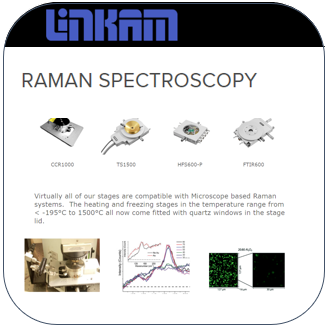A team of researchers from Leoben, Austria are using Raman spectroscopy to identify compositional defects in the lattice of ceramic perovskites, giving valuable insight into how to tune and improve the quality of ferroelectric ceramic materials used for a range of applications including in sensors, telecommunications, and energy storage.
Perovskite ceramic materials – referring to a number of ceramic compounds that possess a lattice-like crystalline structure of the same type as calcium titanium oxide (CaTiO₃) – have been widely used in recent years across a variety of applications due to their tuneable semiconducting and ferroelectric properties. One such compound is barium titanate (BaTiO₃), a dielectric ceramic which undergoes temperature-dependent structural phase transitions, the most notable occurring at ~125°C, that defines the change from a ferroelectric to a paraelectric state (i.e. the Curie temperature). Barium titanate is the most important material used in capacitor technology, and its dielectric properties can be modified by compositional tuning. By better understanding the structural changes and defects induced by chemical modifications, researchers can aid advancements in the design of new perovskite materials.
1. SEM images (left) demonstrating the influence of additives to the microstructure of barium titanate compounds and Raman spectra (right) showing remarkable changes in their lattice dynamics (different spectral signatures) compared to pure barium titanate at the bottom. Figure reprinted from reference 1 with permission under CC BY 4.0.
In this work, the researchers formulated several barium titanate (BT)-based compounds with additives intended to induce or suppress defects in the lattice structure. They knew that the Raman emissions are indicative of defects in the perovskite structure, such as for example cation vacancies. The research team used temperature-controlled Raman spectroscopy to characterise the prototypical Raman modes of BT, at each temperature observing characteristic Raman peaks of the rhombohedral (−185°C), tetragonal (25°C) and cubic (175°C) phases, whilst also looking for possible extra-modes due to defects. They used a Linkam THMS600 temperature control stage to measure the Raman spectra at various temperatures.
Dr. Marco Deluca leads the Functional Materials Team at the Materials Center Leoben Forschung GmbH in Leoben, Austria, where extensive work is carried out on advanced ferroelectric and electroceramic materials with an aim of developing improved materials for sensor and energy storage applications. “Knowing the defect landscape created by chemical substituents is the key to tune how the ceramics respond to applied electric fields, and so is decisive for the application. The Linkam THMS600 stage is a tool we extensively use to understand these aspects, and we are also working on concurrently applying electric field and temperature, using Linkam stages equipped with electric pins (like the HFS600E-PB4).”, comments Dr. Deluca. “We hope that this work will be an important demonstration of the usefulness of Raman spectroscopy fitted with Linkam stages especially to study the local chemistry of ceramic materials’’, adds Vignaswaran K. Veerapandiyan, PhD student in Dr. Deluca’s team.
The Functional Materials Team is funded by both Austrian national projects and EU projects, including one ERC Consolidator Grant project awarded to Marco Deluca in 2018 (Project CITRES, GA NR. 817190). The research reported here was specifically funded by the Austrian Science Fund (FWF) project P29563-N36.
2. Vignaswaran K. Veerapandiyan (left) and Dr. Marco Deluca (right), the authors of the present work, in their office at the Materials Center Leoben.
This research, recently published in the Journal of the European Ceramic Society (JECS), goes on to detail how different compositional substitutions in barium titanate result in the observation of different Raman modes, specifically looking at one lattice position known as the B-site. For example, they found that BNbT (where the BT B-site is chemically modified with Nb⁵⁺) was observed to have an additional peak at high wavenumbers (Raman mode 7 at ~830 cm-1) with respect to the reference BT, as can be seen in the Raman spectra shown in the figure above. The same peak appeared also with the addition of La³⁺ (BLaT), but not with simultaneous addition of Ga³⁺ and Nb⁵⁺ (BGaNbT). Since the appearance of Ti vacancies is a possible defect compensation for both La³⁺ and Nb⁵⁺ addition, but not for BGaNbT (where Ga³⁺ provides the necessary charge compensation), the appearance of this mode proved the availability of Ti vacancies in the lattice of BLaT and BNbT.
This conclusion is strengthened by the temperature evolution of this extra Raman Mode 7, which they measured using the THMS600 temperature control stage in conjunction with a Horiba LabRAM 300 spectrometer to observe the evolution of the Raman mode 7 peak as a function of increasing temperature between 25 °C and 300°C. As seen in the spectra below, the peak position of mode 7 remains stable with temperature. This suggests a high localization (i.e. near-defect) of this vibrational mode, as opposed to other lattice modes that display a large temperature-induced shift. This further analysis unambiguously assigns this mode to the presence of Ti vacancies.
3. Graph of temperature-controlled Raman spectroscopy showing the Raman shift of BNbT - the temperature dependent evolution of its Raman mode 7. Figure reprinted from reference 1 with permission under CC BY 4.0.
The appearance of the extra modes in these perovskites is thus indicative of lattice order defects, by assigning the observed changes in Raman mode to particular modifications. This work provides valuable insight on the effect of particular chemical adjustments and allows more precise and impactful modifications to be made to future compounds.
References
V. K. Veerapandiyan, et al. "B-site vacancy induced Raman scattering in BaTiO3-based ferroelectric ceramics" Journal of the European Ceramic Society 40 (2020) 4684-4688 DOI:10.1016/j.jeurceramsoc.2020.05.051
Related Content





